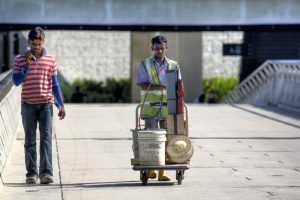Foreign labour shortages in construction sector is a wake-up call for change
June 23, 2021

In a commentary published by Channel News Asia, Dr Kelvin Seah Kah Cheng (NUS Department of Economics) writes about the overreliance on low-skilled foreign labour in the construction sector. The recent COVID-19 pandemic exposed the flaws of this strategy after a large portion of construction workers last year fell ill, causing delays in the construction of many Build-To-Order (BTO) flats.
Dr Seah suggests that a reintroduction of trade schools could help alleviate Singapore’s overreliance on low-cost foreign labour, since these trade schools could potentially boost the supply of Singaporeans working in essential areas like construction. However, since many Singaporeans hold the perception that vocational educations do not lead to highly-paid jobs, beyond establishment of these trade schools, Dr Seah recognises that in order to attract locals, wages in the construction sector need to increase as well.
There are also issues like manpower where redeploying 300,000 Singaporeans to replace the foreign workers currently working in the construction sector comes with a high opportunity cost and may be even too unrealistic of a goal to achieve.
Instead, Dr Seah argues that in a market-driven economy like Singapore, a practical approach where companies utilize more capital-intensive technology rather than depending on traditional labour-intensive methods to perform the same menial job is most suitable.
Though these labour-saving technologies have been around for a while, with a large supply of cheap foreign labour to fall back on, greater incentivization is needed to encourage companies to take up these new forms of technology and consequently reduce their reliance on foreign workers. By transforming the construction sector to tap on more capital-intensive forms of production, Singapore can reduce its reliance on foreign labour and at the same time increase wages for those working in the construction sector since productivity output can be expected to increase.
However, companies may be resistant in their uptake of new automation processes as they may underestimate the amount of savings they may reap in the long run. Furthermore, they may find the upfront costs of these labour-saving technologies to be too high, or otherwise simply feel more comfortable with the way they have operated thus far and see no reason for change.
With the disruptions that COVID-19 has brought to the construction sector, Dr Seah hopes that this pandemic can enable companies to realise the importance of switching to labour-saving technologies to better shield Singapore from any foreign labour supply disruptions that may reoccur in the future.
Read the article here.
